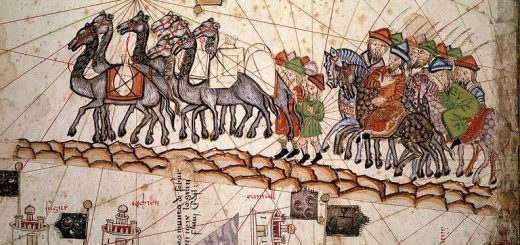The Story of Islam in China
The Muslim Ummah faces so many crises at present that once we close a file have to open another. We might perhaps open tens of files simultaneously. For example, the issues of Palestine, Iraq, Sudan, Afghanistan, Somalia and Chechnya are on fire. Likewise, issues of China, Germany, France and Denmark are also hot. Actually, our issues and crises are so many that some Muslims motivated by depression might think the crack is beyond repair, in the sense that there is no hope of reform and no chance for revival. However, depression has no room in Islam, because to Allah belong the keys of the heavens and the earth. Thus, Allah would grant us His triumphant victory in the manner, and at the time, He likes provided that we are righteous and straightforward. Moreover, thorough study of history proves that victory comes after patience, ease follows from hardship and that the darkest hour is just before the dawn.
I preferred to begin with this introduction so that despair might not make its way through the hearts of Muslims when we are about to deal with a new tragedy, added to the multiple tragedies the Ummah experiences, i.e. the tragedy of Muslims in East Turkestan, where the Muslim people there, known as Uighurs, are ethnically persecuted by Chinese authorities. Actually, this is not the first time for me to deal with the Chinese Muslims crisis. I have already tackled the Muslims problem in Tibet, a Chinese territory, in a previous article “The Story of Tibet”. It seems that such files may not be closed soon as they represent deep-rooted problems.
Roots of the problem
 We have to explore the roots and the origins of the issue in order to have a clear vision about the story. Moreover, it is necessary to draw a connection between East Turkestan events and events of Tibet as well as of other Chinese territories.
We have to explore the roots and the origins of the issue in order to have a clear vision about the story. Moreover, it is necessary to draw a connection between East Turkestan events and events of Tibet as well as of other Chinese territories.  Therefore, I found it useful, before going into the story of Uighurs and their relation to Turkestan, to deal with the story of Islam in China in general and have a simple idea about the nature of the people and the land in the region of Turkestan bordering China. The word Turkestan, consisting of two syllables, Turk and stan, is Persian for “land of the Turks”. Turks belong to the yellow (Mongoloid) race known as the descendants of Japheth the son of Noah. They are native Muslim peoples who embraced Islam very early. Furthermore, there were among them those who bore the Islamic flag and led the whole Muslim world during many stages of the Islamic history.
Therefore, I found it useful, before going into the story of Uighurs and their relation to Turkestan, to deal with the story of Islam in China in general and have a simple idea about the nature of the people and the land in the region of Turkestan bordering China. The word Turkestan, consisting of two syllables, Turk and stan, is Persian for “land of the Turks”. Turks belong to the yellow (Mongoloid) race known as the descendants of Japheth the son of Noah. They are native Muslim peoples who embraced Islam very early. Furthermore, there were among them those who bore the Islamic flag and led the whole Muslim world during many stages of the Islamic history.
Ottomans typically confused with Turks
Many people confuse the word “Turks” with the word “Ottomans” thinking them to be synonyms. However, all Ottomans are Turks but not vice versa. Actually, there are many non-Ottoman Turks. In fact, Ottomans constitute only a small branch of great Turk tribes, from among whom many everlasting figures in our history rose, such as the Seljuk Sultan Alp Arslan, Imad Ad-Din Atabeg Zengi, Nur Ad-Din Mahmud, Ahmad ibn Tulun and many others.
The term “Turks” is applied in its wider meaning to the peoples of Central Asia, the Caucasus mountains and areas of the Caspian Sea. Some Turks immigrated to remote places such as Asia Minor (today’s Turkey) although all Turks still maintain their Turkic origins, which spots light on the vivid interaction of the Turkish people with the Chinese Muslims issue due to their common ethnic genealogy. This is in addition to the increasing Islamic passion fueled by the leadership of the successful Islamic leader ErdoÄŸan.
Historians divided the Turk’s lands into two main divisions: East Turkestan (located within Chinese borders) and West Turkestan, a vast land which included what is now Turkmenistan, Uzbekistan, Tajikistan, Kyrgyzstan, Kazakhstan, parts of Afghanistan and parts of Iran in addition to the Russian-occupied Chechnya and Dagestan.
Introduction of Islam into Turkestan
Islam made its way into West Turkestan very early during the caliphate of ‘Umar bin Al-Khattab and ‘Uthman bin ‘Affan (may Allah be pleased with them). Turkic peoples embraced Islam in throngs. Later on, caravans of Du’ah (callers to Allah) and merchants moved from West Turkestan to East Turkestan and to China to attract a good number of them to Islam.
During the Umayyad Caliphate missions sent to call Chinese to Allah’s religion were as much as 16. However, an essential development and upswing took place by the arrival of the Muslim army led by Qutaibah bin Muslim Al-Bahili at East Turkestan to conquer it and invade its capital Kashgar. This helped the native inhabitants of the country, i.e. Turkic Uighurs, know Islam closely and thus hurried to embrace Islam in throngs. This way, East Turkestan turned into a purely Islamic territory. This great conquest took place in 96 A.H./ 714 A.D. lately during the reign of the Umayyad Caliph Al-Walid ibn Abd Al-Malik.
Du’ah caravans made this territory its starting point in the region. They moved to the south toward Tibet, which formed the Tibet’s first encounter with Islam. Tibet’s people began to embrace Islam and sent to Khurasan’s governor Al-Jarrah bin Abdullah during the reign of the great Umayyad Caliph ‘Umar bin Abdul-‘Aziz asking him to send Islamic scholars to Tibet to teach its people Islam.
Based in East Turkestan, Du’ah delegations headed also for China, which had the effect of increasing the number of Chinese Muslims. This is in addition to 12 Islamic missions sent to China during the Abbasid Caliphate, which resulted in better knowledge about Islam.
It is worth mentioning that during this early period Muslims used to peacefully co-live in the Chinese society or in Tibet with Buddhists and adherents of other religions, a period which recorded no religious or political clashes. Moreover, Muslims living in East Turkestan used to deal kindly with the huge numbers of idolaters sharing with them the same territory in accordance with the fundamental Islamic rule “There is no coercion in religion”.
Spread of Islam after Satuq Boghra Khan’s conversion to Islam
In 323 A.H./943 A.D., a great upswing took lace in East Turkestan after Satuq Bughra Khan, the Uighur Turkic Qarakhanid Khan, had converted to Islam. Thanks to this great man’s conversion to Islam, more than 200,000 Turkic tribes embraced Islam, i.e. more than one million persons embracing Islam simultaneously. This recalls the example of the reverend Comapnion Sa’d bin Mu’adh thanks to whose embracement of Islam the whole tribe of Aws converted to Islam. Based on this, East Turkestan grew a very mighty country and started to be of a distinguished developed civilization. The state grew much more stronger during the reign of Satuq’s grandson Harun (or Hasan) Bughra Khan titled as Shihab Al-Dawlah and the Da’wah Supporter. He dedicated one-fifth of agricultural lands for the establishment of Islam-teaching schools. Moreover, he introduced writing Turkestani and Uighur languages in Arabic letters, which represented an advanced step towards Turkic steadfast sticking to Islam making it easier for them to read the Qur’an, Hadith and Islamic references.

In 435 A.H./ 1043 A.D., Uighurs could convince ten thousand Turkic Kyrgyz tribes to convert to Islam, which constituted a great addition to the Turkestan state. At that time, the Turkestan state paid allegiance to the Abbasid Caliph Al-Qadir Bil-Lah and thus would mention his name in Friday sermons and engraved his name on their currency although he had no actual authority over the country. However, they did so out of an Islamic orientation and a desire to join Muslim forces.
Tatar invasion
The state of affairs remained as such till the world was afflicted by the great disaster, i.e. the Mongolian tyrant Genghis Khan in 603 A.H./1206 A.D. He swept so quickly the surrounding countries being based in Mongolia. East Turkestan had to face the first Tartaric attack. However, Tatars crushed the country committing many massacres and the country could easily be subjugated by the Tartaric Sultan, bearing in mind that the Islamic world in general was suffering from a period of weakness.

After the death of Genghis Khan, disagreement arose among his successors which ended up with dividing the vast Tartaric kingdom into many parts. We will deal here with only two parts thereof. The first part included Mongolia and East Turkestan and was headed by Arigh Bukha who belonged to the family of Ogedei the Mongol. This part included East Turkestan as a whole. However, Tartars relationship with Muslims got much better to the extent that a Tartar leader, Tirma Chibrine, embraced Islam, which resulted in many Mongols converting to Islam. Actually, it is a one of the wonders of history that the subjugating occupiers embraced the religion of those subjugated and occupied. Undoubtedly, this took place due to the greatness and cogency of Islam (And Allah has full power and control over His Affairs, but most of men know not). This great conversion to Islam took place in 722 A.H./1322 A.D.
By the way, this was not the first time a Mongol converts to Islam. Actually, Berke Khan, one of their great leaders, had accepted Islam before. By virtue of his acceptance of Islam, his tribe, the Golden Horde who lived in Caucasia, embraced Islam.
Chinese Muslims and the two dynasties of Kublai and Möngke
The second part we are to deal with here is the China region. When China came under the rule of Kublai the son of Tolui the Mongol, he named Khanbaliq (modern-day Beijing) as his capital. It is amazing that this state would highly appreciate Muslims although Tartaric armies had slaughtered thousands of Muslims before in Muslim countries.
 Kublai dynasty employed many Muslims in administrative posts. Muslims became a favored class of officials as they were well educated, honest, well-mannered and of efficient administrative abilities. They did not only employ Chinese Muslims but also Muslims coming from East or West Turkestan. It was so notable that at a time Muslim leaders ruled ten out of 12 Chinese provinces. Shams Al-Din Umar was the most influential Muslim at that time. He was promoted from a an army officer in the Mongol army ruling China to be the military ruler of the city of Thai Yuan and then of the city of Binyang. He was then appointed as the judge, and thereafter the ruler, of Beijing, the capital of China. The Muslim ruler set about establishing a good number of Islamic schools in China. Perhaps most today’s mosques in China have been established during the Mongolian era in view of the great esteem Muslims were held in.
Kublai dynasty employed many Muslims in administrative posts. Muslims became a favored class of officials as they were well educated, honest, well-mannered and of efficient administrative abilities. They did not only employ Chinese Muslims but also Muslims coming from East or West Turkestan. It was so notable that at a time Muslim leaders ruled ten out of 12 Chinese provinces. Shams Al-Din Umar was the most influential Muslim at that time. He was promoted from a an army officer in the Mongol army ruling China to be the military ruler of the city of Thai Yuan and then of the city of Binyang. He was then appointed as the judge, and thereafter the ruler, of Beijing, the capital of China. The Muslim ruler set about establishing a good number of Islamic schools in China. Perhaps most today’s mosques in China have been established during the Mongolian era in view of the great esteem Muslims were held in.
The Kublai dynasty remained in authority till it was overthrown by the celebrated Chinese dynasty of Möngke, which extended its dominance to areas outside China and subdued East Turkestan that was then ruled by the Ogedei dynasty.
In spite of the great strategic change that took place through the Chinese taking over authority from Mongols, Muslims still enjoyed a distinguished position in China as well as in East Turkestan. The Möngke dynasty followed the same steps of the Mongol Kublai dynasty appointing scientifically, culturally and economically prominent Muslims in high administrative posts. The state of affairs continued as such till 1052 A.H./ 1642 A.D.
Muslims persecuted during the reign of Manchus
The year 1052 A.H./ 1642 A.D. witnessed the downfall of the Möngke dynasty and the rise of a new Chinese state headed by Manchus, native to Manchuria. They practiced a new approach in dealing with Muslims, which is the conflict approach. Worrying about Muslims influence, Manchurians began to oppress and persecute them. The situation was worsened by the discovery of a plan to re-bring a Möngke prince to authority by the help of Muslims in 1058 A.H./ 1648 A.D. The situation was escalated by the Manchurian dynasty who killed five thousand Muslims. Tension extended more grievously to the province of Gansu, a province near to East Turkestan of the Muslim majority. Manchus tried more than once to conquer East Turkestan, that turned into a purely Islamic territory where the Muslim community consisted of a mixture of Mongols and Turkic Uighurs after Mongols had embraced Islam. However, these attempts were in vain in the beginning till Manchurians managed to occupy East Turkestan in 1172 A.H./ 1759 A.D., an occupation which lasted for tens of years. Anyway, the occupation was interposed by a 13-year Islamic Turkic rule, which was once again discontinued by the Chinese occupation with the help of the British in 1292 A.H./ 1876 A.D. The Manchurian dynasty immediately changed the territory name “East Turkestan”, into Xinjiang or Sinkiang (Chinese=new frontier) in an attempt to efface the Islamic identity and the Arabic history of the region.
The Manchurian dynasty applied many oppressive measurements to the territory of East Turkestan and appointed to it a Muslim ruler whose loyalty was to them and who was much more repressive to Muslims than the Chinese population itself. However, they did not that violently oppress Muslims living in China itself. Moreover, they tried to cool down the situation with Muslims but allowed them no great freedom to publicize their religion. Besides, the celebrated Ottoman Caliph Abdul-Hamid II tried to have close ties with Chinese Muslims sending to them many religious missions, which were resisted by the Chinese government and thus were of little significance and effect.
Republican rule and recognition of Muslims
In 1329 A.H./ 1911 A.D., the Manchurian dynasty was overthrown with the help of Muslims to be replaced by the republican rule in China. From its earliest days, the republican rule admitted that Muslims represent a fundamental constituent of the Chinese state.  The Chinese state consisted of five major constituents, the Chinese (belonging to the Han dynasty), Manchurians, Mongols, Muslims (mostly belonging to the Chinese Hui tribe) and Tibetans. The Chinese flag showed firstly five stripes representing the five great races in China’s history: red for Han Chinese, yellow to represent Manchus, blue for Mongols, white for Muslims and black for Tibetans. Therefore, Muslims situation cooled down so much in China with the exception of East Turkestan, whose freedom of movement was thought by republicans to give its people a chance to separate from China. Accordingly, religious freedom was given to the Hui Chinese (or emigrants) but was not given to Turkic Uighurs in East Turkestan.
The Chinese state consisted of five major constituents, the Chinese (belonging to the Han dynasty), Manchurians, Mongols, Muslims (mostly belonging to the Chinese Hui tribe) and Tibetans. The Chinese flag showed firstly five stripes representing the five great races in China’s history: red for Han Chinese, yellow to represent Manchus, blue for Mongols, white for Muslims and black for Tibetans. Therefore, Muslims situation cooled down so much in China with the exception of East Turkestan, whose freedom of movement was thought by republicans to give its people a chance to separate from China. Accordingly, religious freedom was given to the Hui Chinese (or emigrants) but was not given to Turkic Uighurs in East Turkestan.
Independence of East Turkestan
China engaged in a fierce war with Japan, which ended up with the Japanese occupying the Chinese capital Beijing in 1352 A.H./ 1933 A.D. Although the Japanese committed many massacres against the Chinese, they, at the same time, gave a great scope of freedom to Muslims in order to cause some balance in the region. The Turkic people in East Turkestan seized the opportunity and managed to gain independence from China and the short-lived self-proclaimed East Turkestan Republic was declared in 1352 A.H./ 1933 A.D. On year later, the Chinese republic united with Russians and both re-occupied East Turkestan re-annexing it to China in 1353 A.H./ 1934 A.D. despite the Japanese occupation of China. The Chinese executed the Turkestan president Xoja Niyaz and prime minister Damolla as well as ten thousand Muslims.
Communist occupation of Turkestan
World War II, broke out in 1358 A.H./ 1939 A.D. and ended in 1364 A.H./ 1945 A.D., resulted in the defeat of Japan and thus its withdrawal from China. Meanwhile, Mao Zedong led the Communist revolution in China which had many repercussions.
 Republicans ruling China stepped aside for new Communists and headed for Taiwan. Declaring Taiwan’s independence from China, they have been strongly supported by the whole Western world. Moreover, Russians tried to expand in East Turkestan at the expense of China allying with some Muslim powers there. They already managed to dominate northern East Turkestan. However, Mao Zedong invaded East Turkestan in 1369 A.H./ 1949 A.D. to put an end to all Muslim and Russian attempts through annexing the territory of East Turkestan (or the so-called Xinjiang) to China.
Republicans ruling China stepped aside for new Communists and headed for Taiwan. Declaring Taiwan’s independence from China, they have been strongly supported by the whole Western world. Moreover, Russians tried to expand in East Turkestan at the expense of China allying with some Muslim powers there. They already managed to dominate northern East Turkestan. However, Mao Zedong invaded East Turkestan in 1369 A.H./ 1949 A.D. to put an end to all Muslim and Russian attempts through annexing the territory of East Turkestan (or the so-called Xinjiang) to China.
In your opinion, what approaches are followed by Communists to efface the Islamic identity of Turkestan? What measures did they take against Turkic Uighurs, the native inhabitants of the great territory? Why is China strongly committed to claiming right to the territory? What did Uighurs do to get rid of such an abominable occupation? What is our role, as Muslims, regarding such a serious issue? Answers to these question will be the scope of our next article, if Allah so wills.
I ask Allah to glorify Islam and Muslims.
Dr. Ragheb ElSergany
https://www.islamstory.com/en/artical/3407498
Number of View :1597















